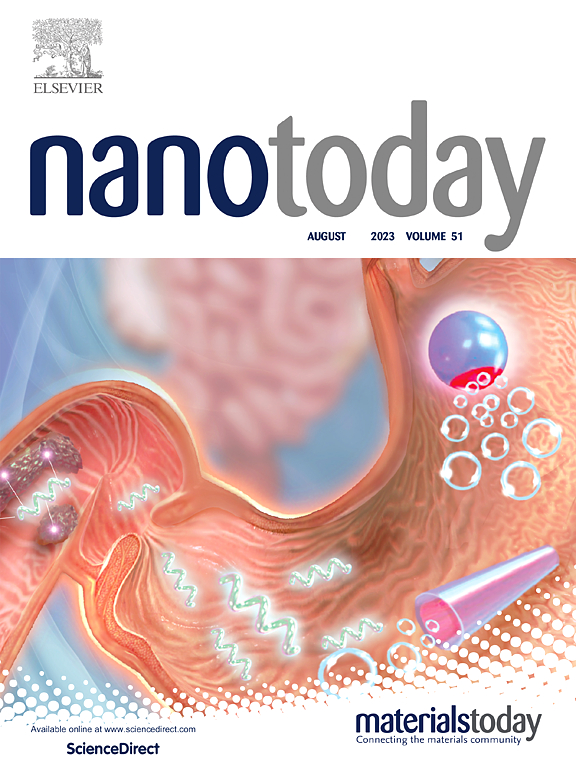Lipidic prodrug nanosponges deliver proteins for combination therapy of candida-biofilm infections
IF 13.2
1区 材料科学
Q1 CHEMISTRY, MULTIDISCIPLINARY
引用次数: 0
Abstract
Lipidic prodrug nanomedicines combine the benefits of nanoparticles and prodrugs, yet their use in conjunction with protein therapeutics has been restricted by the subpar loading and protective capabilities of traditional lipidic prodrug assemblies. To address this challenge, this study introduces lipidic prodrug nanosponges (LPNs) for the loading and protection of proteins, aiming for combination therapy of chemical and protein therapeutics. A ketoconazole-containing lipidic prodrug is synthesized via dynamic boronate bond formation and subjected to assemble to form the nanosponge structures. Regardless of their isoelectric points and molecular weights, proteins can be efficiently loaded into LPNs, achieving a loading efficiency of approximately 60 % due to multivalent interactions. Additionally, LPNs effectively shield proteins from degradation and enable controlled release. Subsequently, the representative DNase I-loaded LPNs effectively prevent the formation of Candida biofilm and destruct mature biofilms through the combined action of DNase I, which eliminates extracellular DNA in the biofilm matrix, thereby enhancing the antifungal efficacy of ketoconazole in combination. Furthermore, DNase I-loaded LPNs efficiently eradicate Candida biofilms and alleviate inflammation in murine models of oral candidosis and model candidal vaginitis, facilitating tissue remodeling. Overall, our LPNs offer an efficient and protective platform for protein delivery in combination therapy.
脂质前药纳米海绵为念珠菌生物膜感染的联合治疗提供蛋白质
脂质前药纳米药物结合了纳米颗粒和前药的优点,但它们与蛋白质疗法的结合使用受到传统脂质前药组件的低负荷和保护能力的限制。为了解决这一挑战,本研究引入了脂质药前纳米海绵(lpn),用于蛋白质的装载和保护,旨在实现化学和蛋白质治疗的联合治疗。通过动态硼酸键形成合成了一种含酮康唑的脂质前药,并将其组装成纳米海绵结构。无论其等电点和分子量如何,蛋白质都可以有效地装载到lpn中,由于多价相互作用,装载效率约为60% %。此外,lpn有效地保护蛋白质免受降解并使其能够控制释放。随后,代表性的负载DNase I的lpn通过DNase I的联合作用,有效地阻止念珠菌生物膜的形成,破坏成熟的生物膜,消除生物膜基质中的细胞外DNA,从而增强酮康唑联用的抗真菌效果。此外,在口腔念珠菌病和模型念珠菌阴道炎的小鼠模型中,装载DNase i的lpn能有效地根除念珠菌生物膜,减轻炎症,促进组织重塑。总的来说,我们的lpn为联合治疗中的蛋白质递送提供了一个有效和保护性的平台。
本文章由计算机程序翻译,如有差异,请以英文原文为准。
求助全文
约1分钟内获得全文
求助全文
来源期刊

Nano Today
工程技术-材料科学:综合
CiteScore
21.50
自引率
3.40%
发文量
305
审稿时长
40 days
期刊介绍:
Nano Today is a journal dedicated to publishing influential and innovative work in the field of nanoscience and technology. It covers a wide range of subject areas including biomaterials, materials chemistry, materials science, chemistry, bioengineering, biochemistry, genetics and molecular biology, engineering, and nanotechnology. The journal considers articles that inform readers about the latest research, breakthroughs, and topical issues in these fields. It provides comprehensive coverage through a mixture of peer-reviewed articles, research news, and information on key developments. Nano Today is abstracted and indexed in Science Citation Index, Ei Compendex, Embase, Scopus, and INSPEC.
 求助内容:
求助内容: 应助结果提醒方式:
应助结果提醒方式:


